�
NIST Standard Reference Database 23
NIST Reference Fluid Thermodynamic and Transport Properties—
REFPROP
Version 9.0
User's Guide
Eric W. Lemmon
Marcia L. Huber
Mark O. McLinden
Thermophysical Properties Division
National Institute of Standards and Technology
Boulder, Colorado 80305
November, 2010
U.S. Department of Commerce
Technology Administration
National Institute of Standards and Technology
Standard Reference Data Program
Gaithersburg, Maryland 20899
�
The National Institute of Standards and Technology (NIST) uses its best efforts to deliver a high quality
copy of the Database and to verify that the data contained therein have been selected on the basis of
sound scientific judgment. However, NIST makes no warranties to that effect, and NIST shall not be liable
for any damage that may result from errors or omissions in the Database.
©2010 copyright by the U.S. Secretary of Commerce on behalf of the United States of America. All rights reserved. No part of this
database may be reproduced, stored in a retrieval system, or transmitted, in any form or by any means, electronic, mechanical,
photocopying, recording, or otherwise, without the prior written permission of the distributor.
Certain trade names and other commercial designations are used in this work for the purpose of clarity. In no case does such
identification imply endorsement by the National Institute of Standards and Technology, nor does it imply that the products or
services so identified are necessarily the best available for the purpose.
Microsoft, Windows, Excel, and Visual Basic are either registered trademarks or trademarks of the Microsoft Corporation in the
United States and/or other countries; MATLAB is a trademark of MathWorks.
�
ACKNOWLEDGEMENTS
We gratefully acknowledge the many contributions of our colleagues and associates. Gary Hardin (of
NIST) provided support with the help file and the installation package. Allan Harvey (of NIST) and Frank
Doyle provided very thorough and greatly appreciated debugging of REFPROP. Diego Ortiz (of Texas
A&M University) helped with the new VLE routine added in version 9.0. Arno Laesecke (of NIST)
provided an extensive collection of viscosity data. Lennart Vamling (of the Chalmers University of
Technology in Sweden), Johannes Lux (of the German Aerospace Center), and Paul Brown (of Ramgen
Power Systems) aided in the MATLAB link. Chris Muzny (of NIST) aided with the link to C++, and with
the MatLab link.
Previous versions of the REFPROP database were developed by Graham Morrison and John Gallagher.
Jim Ely, Dan Friend, and Marcia Huber wrote the early versions of the related databases NIST12 and
NIST14 from which we have extracted algorithms. We thank Sanford Klein and Adele Peskin, the
programmers of the original graphical interface implemented in version 6. We had many helpful
discussions with Dan Friend, Allan Harvey, Roland Span, Arno Laesecke, Richard Perkins, and Reiner
Tillner-Roth.
We also made extensive use of the CATS Database for Pure Fluids and Mixtures of the Center for
Applied Thermodynamic Studies of the University of Idaho, Moscow, Idaho, the NIST/TRC SOURCE and
TDE Databases, the AIChE DIPPR database, and the Dortmund Data Bank for Pure Component
Properties (DDB-Pure), Oldenburg, Germany in fitting the models implemented in REFPROP. Finally, we
acknowledge our many colleagues whose property measurements and models we have taken from the
literature, and without which this database would be much reduced in scope.
Development of this software package was supported by the NIST Thermophysical Properties Division
and the NIST Standard Reference Data Program. The development of previous versions was supported
by the Air-Conditioning and Refrigeration Technology Institute and the U.S. Department of Energy. Model
development and measurements at NIST have been supported over a period of many years by numerous
sponsors including the Air-Conditioning and Refrigeration Technology Institute, the U.S. Department of
Energy, the Electric Power Research Institute, the Environmental Protection Agency, Oak Ridge National
Laboratory, the American Society of Heating, Refrigerating and Air-Conditioning Engineers, and the
Building Environment and Thermophysical Properties Divisions of NIST.
�
CONTENTS
1. INTRODUCTION..........................................................................................................................1
1.1 Objectives and Scope of the Database ...............................................................................1
1.2 Uncertainties in Calculated Properties.................................................................................1
1.3 Organization of the User's Guide.........................................................................................1
2. INSTALLATION ............................................................................................................................2
2.1 System Requirements..........................................................................................................2
2.2 Installation............................................................................................................................3
3. OVERVIEW ..................................................................................................................................3
3.1 Database Structure ..............................................................................................................3
3.2 Use of the Database ............................................................................................................3
3.3 Overview of the Menus ........................................................................................................3
3.4 Cautions...............................................................................................................................4
4. DEFINING THE FLUID OF INTEREST........................................................................................6
4.1 Selecting a Pure Fluid..........................................................................................................6
4.2 Selecting a Pseudo Pure Fluid ............................................................................................6
4.3 Selecting a Predefined Mixture............................................................................................7
4.4 Defining a New Mixture........................................................................................................7
4.4.1 Defining the mixture name and composition ..............................................................8
4.4.2 Storing a mixture for future use..................................................................................9
4.4.3 Specifying a fluid set ..................................................................................................9
4.5 The Status Bar ...................................................................................................................10
4.5.1 Pure-fluid information screen ...................................................................................10
4.5.2 Changing property models .......................................................................................11
4.5.3 Mixture information screen.......................................................................................12
4.6 Viewing Mixture Parameters..............................................................................................12
4.7 Changing Mixture Parameters ...........................................................................................13
5. GENERATING PROPERTY TABLES........................................................................................14
5.1 Calculating Saturation Tables............................................................................................14
5.2 Calculating Iso-Property tables..........................................................................................16
5.3 Calculating Tables at Specified State Points.....................................................................17
5.4 Calculating Saturation Properties at Specified Points .......................................................20
5.5 Reformatting Existing Data Tables ....................................................................................21
5.6 Warnings and Errors ..........................................................................................................21
6. CREATING AND MODIFYING PLOTS......................................................................................23
6.1 Plotting Data from Tables ..................................................................................................23
6.2 Overlaying Data onto Existing Plots ..................................................................................24
6.3 Predefined Diagrams .........................................................................................................24
6.3.1 Diagrams of thermodynamic surfaces......................................................................24
6.3.2 Phase diagrams .......................................................................................................26
6.4 Modifying Plots...................................................................................................................26
6.4.1 The Modify Plot command........................................................................................26
6.4.2 Adding and deleting labels .......................................................................................27
6.4.3 Resizing and moving plots .......................................................................................28
6.4.4 Reading coordinates off a plot..................................................................................28
6.4.5 Zooming....................................................................................................................28
6.4.6 Add a point to a table ...............................................................................................28
7. CHANGING OPTIONS AND PREFERENCES ..........................................................................29
7.1 Units ...................................................................................................................................29
7.2 Enthalpy and Entropy Reference States and Exergy ........................................................30
7.3 Properties Calculated.........................................................................................................31
7.4 Property Order ...................................................................................................................34
7.5 Preferences........................................................................................................................35
�
7.6 Saving Current Options and Preferences ..........................................................................37
7.7 Retrieving Previously Defined Options ..............................................................................38
8. SAVING AND PRINTING ...........................................................................................................39
8.1 Saving and Closing Sessions ............................................................................................39
8.2 Retrieving a Previously Saved Session .............................................................................39
8.3 Saving Tables ....................................................................................................................39
8.4 Printing...............................................................................................................................40
8.5 Exiting REFPROP..............................................................................................................40
9. IMPORTING AND EXPORTING DATA......................................................................................41
9.1 Copying Data or a Plot to the Clipboard ............................................................................41
9.2 Pasting Data from the Clipboard........................................................................................41
9.3 Inserting and Deleting a Row of Data ................................................................................41
10. MANIPULATING DATA TABLES AND PLOTS .......................................................................42
10.1 Arranging Windows on the Screen ..................................................................................42
10.2 Renaming Windows .........................................................................................................42
10.3 Going to a Window...........................................................................................................42
11. THE HELP SYSTEM ................................................................................................................43
APPENDICES
Appendix A. FLUIDS IN THE REFPROP DATABASE ..................................................................44
Appendix B. USING REFPROP WITH OTHER PROGRAMS.......................................................48
B.1 Units....................................................................................................................49
B.2 Naming Conventions ..........................................................................................49
B.3 Excel Spreadsheets............................................................................................49
B.4 Visual Basic Applications....................................................................................53
B.5 Sample C Code...................................................................................................53
B.6 Sample MATLAB Code.......................................................................................53
B.7 Warning and Error Messages .............................................................................54
Appendix C. CONTACTS...............................................................................................................55
�
1. INTRODUCTION
1.1 Objectives and Scope of the Database
REFPROP is an acronym for REFerence fluid PROPerties. This program, developed by the National
Institute of Standards and Technology (NIST), calculates the thermodynamic and transport properties of
industrially important fluids and their mixtures. These properties can be displayed in tables and plots through
the graphical user interface; they are also accessible through spreadsheets or user-written applications
accessing the REFPROP DLL or the FORTRAN property subroutines.
REFPROP is based on the most accurate pure fluid and mixture models currently available. It implements
three models for the thermodynamic properties of pure fluids: equations of state explicit in Helmholtz energy,
the modified Benedict-Webb-Rubin equation of state, and an extended corresponding states (ECS) model.
Mixture calculations employ a model that applies mixing rules to the Helmholtz energy of the mixture
components; it uses a departure function to account for the departure from ideal mixing. Viscosity and
thermal conductivity are modeled with either fluid-specific correlations, an ECS method, or in some cases the
friction theory method.
These models are implemented in a suite of FORTRAN subroutines. They are written in a structured format,
are internally documented with extensive comments, and have been tested on a variety of compilers.
Routines are provided to calculate thermodynamic and transport properties at a given (T,ρ,x) state. Iterative
routines provide saturation properties for a specified (T,x) or (P,x) state. Flash calculations describe single-
or two-phase states given a wide variety of input combinations [(P,h,x), (P,T,x), etc].
A separate graphical user interface, designed for the Windows operating system, provides a convenient
means of accessing the models. It generates tables and plots for user-specified mixtures or a number of
predefined mixtures (air, the commercially available refrigerant blends, and several reference natural gases).
A help system provides information on how to use the program. Information screens that display fluid
constants and documentation for the property models can be called up at any time. Numerous options to
customize the output are available as well as capabilities to copy and paste to and from other applications.
The property models can also be accessed by other applications (such as spreadsheets) through use of a
dynamic link library (DLL).
1.2 Uncertainties in Calculated Properties
Our objective in selecting property models for use in REFPROP was to implement the most accurate models
currently available. The user should be aware that the uncertainties in these models vary considerably,
depending on the fluid, property, and thermodynamic state. It is thus impossible to give a simple, global
statement of uncertainties. Even for the most-studied fluids with equations of state based on accurate, wide-
ranging data, uncertainties are complicated functions of the temperature and pressure. The interested user is
referred to the original literature sources for details. (References to the literature are accessible through the
fluid and mixture information screens described in Sections 4.5.1 and 4.6.)
The user is further cautioned that, by the very nature of a calculational program, property data are often
displayed with more digits than can be justified based on the accuracy of the property models or the
uncertainties in the experimental data to which the models were fitted.
1.3 Organization of the User's Guide
Section 2 details the installation procedure. Section 3 presents a brief overview of the structure of the
program and its main features. Sections 4 through 11 describe the features of the program in detail. The
fluids in the database are tabulated in Appendix A. Use of the FORTRAN property subroutines is described
in Appendix B. Use of the property routines with Excel spreadsheets and Visual Basic programs is outlined in
Appendix B. Appendix C lists support contacts at NIST.
REFPROP 1
�
2.1 System Requirements
2. INSTALLATION
REFPROP is designed to run on any personal computer running the Microsoft® Windows® 98, 2000, XP,
Vista, or similar operating system. The program requires 20 MB of hard disk space.
2.2 Installation
Place the REFPROP CD-ROM in the CD drive. Click [START], select [RUN] type in: D:\NIST2309, or
whichever driver letter is associated with your CD reader. Follow the remainder of the installation
instructions. By default, REFPROP is installed in the C:\Program Files\REFPROP directory, but this can be
changed by the user at installation. The user is cautioned to not change the names of the various files and
subdirectories that are installed.
REFPROP 2
�

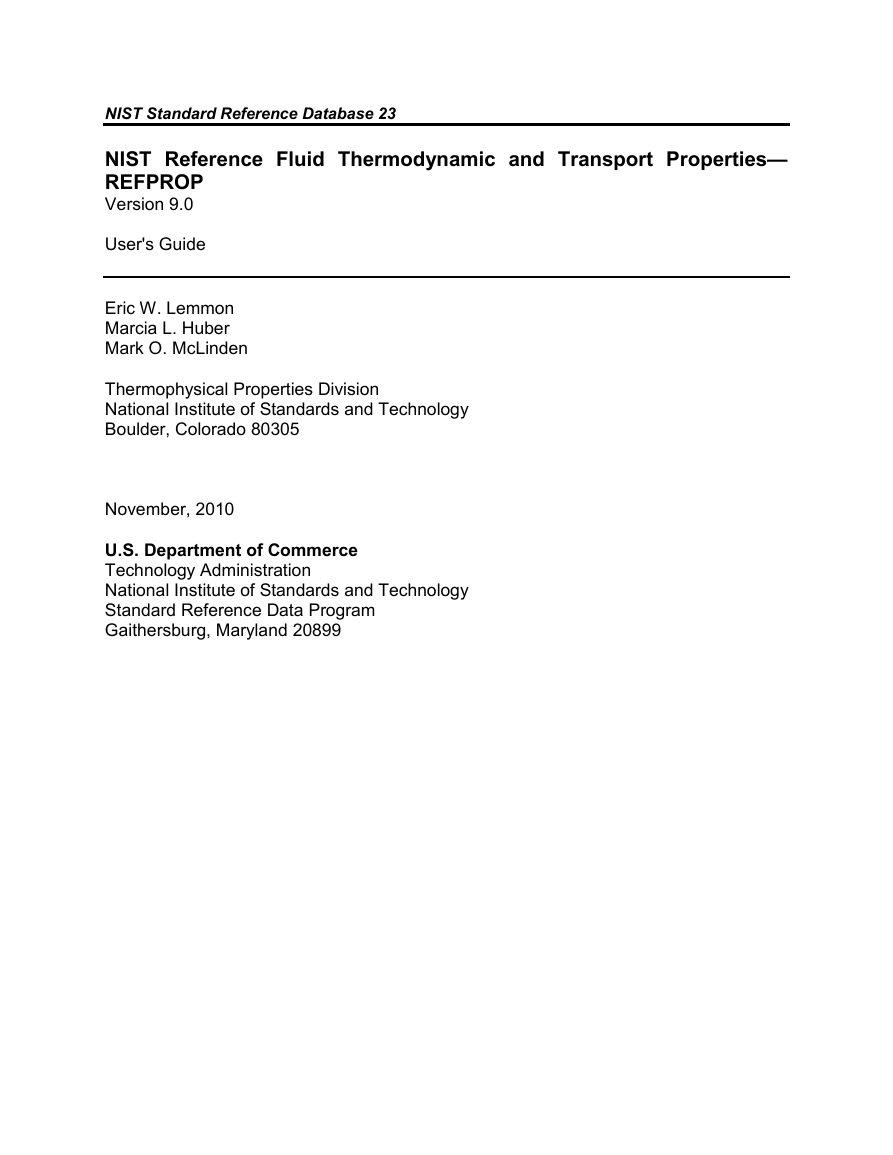
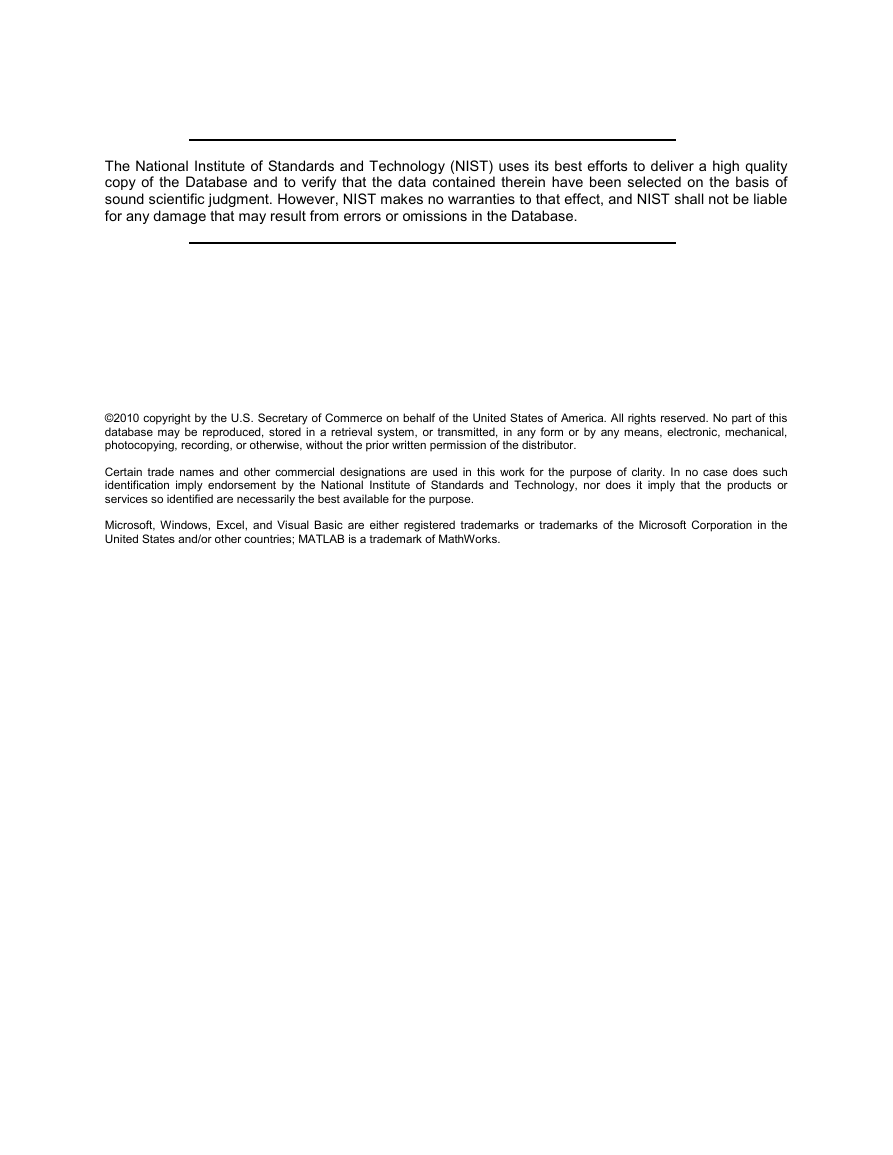

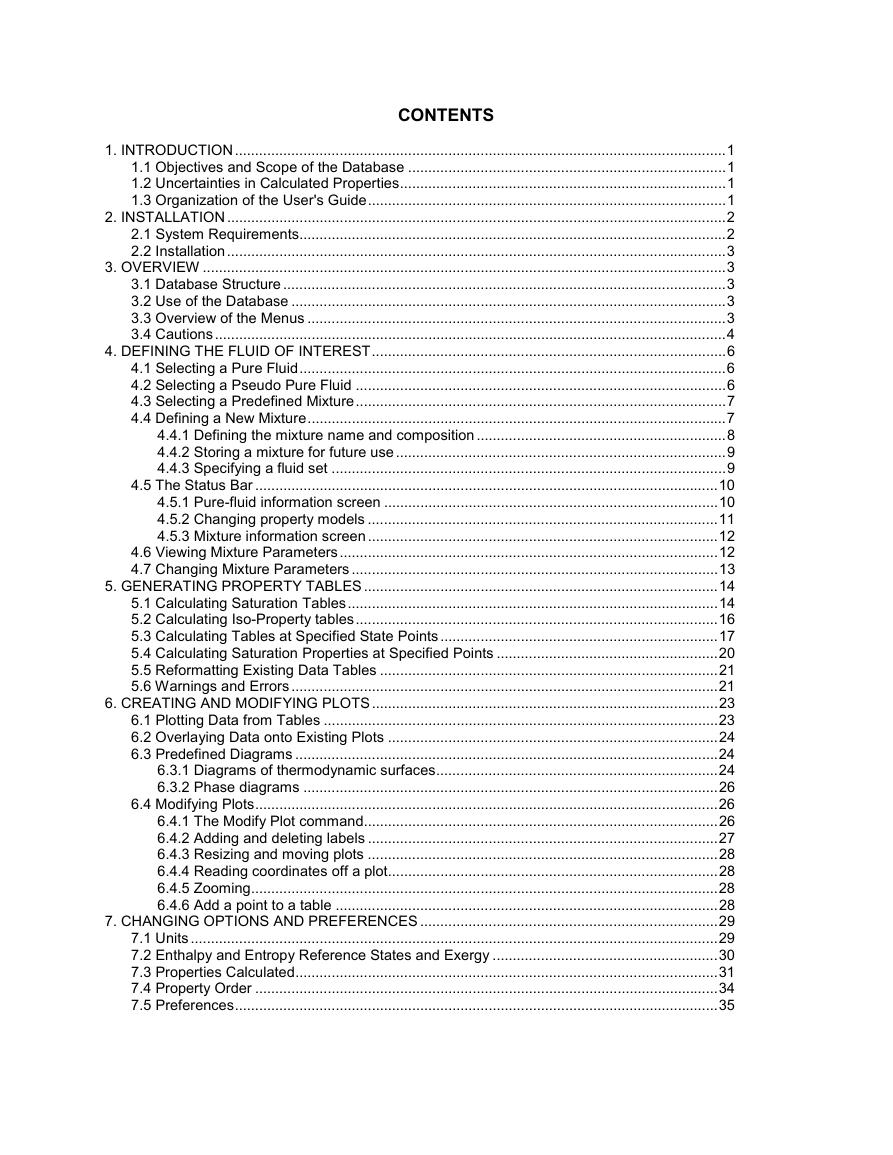
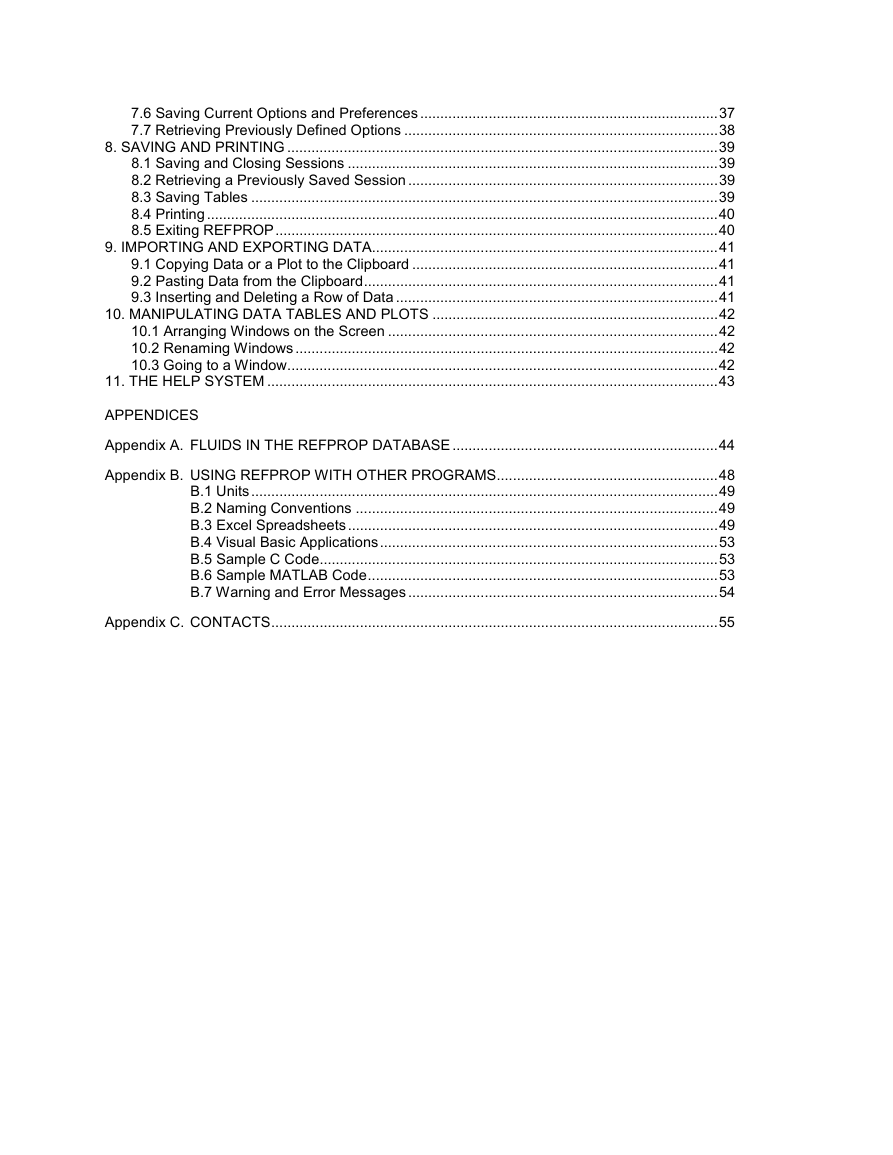
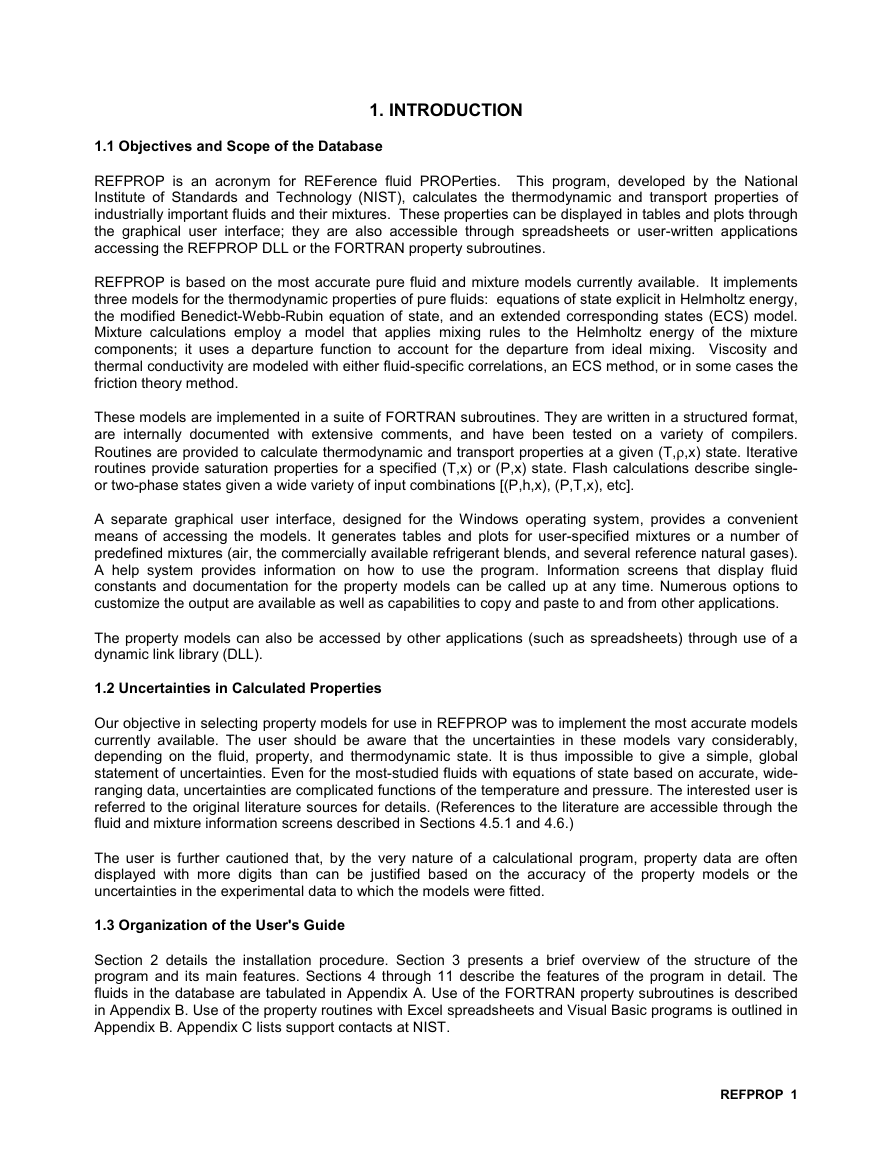
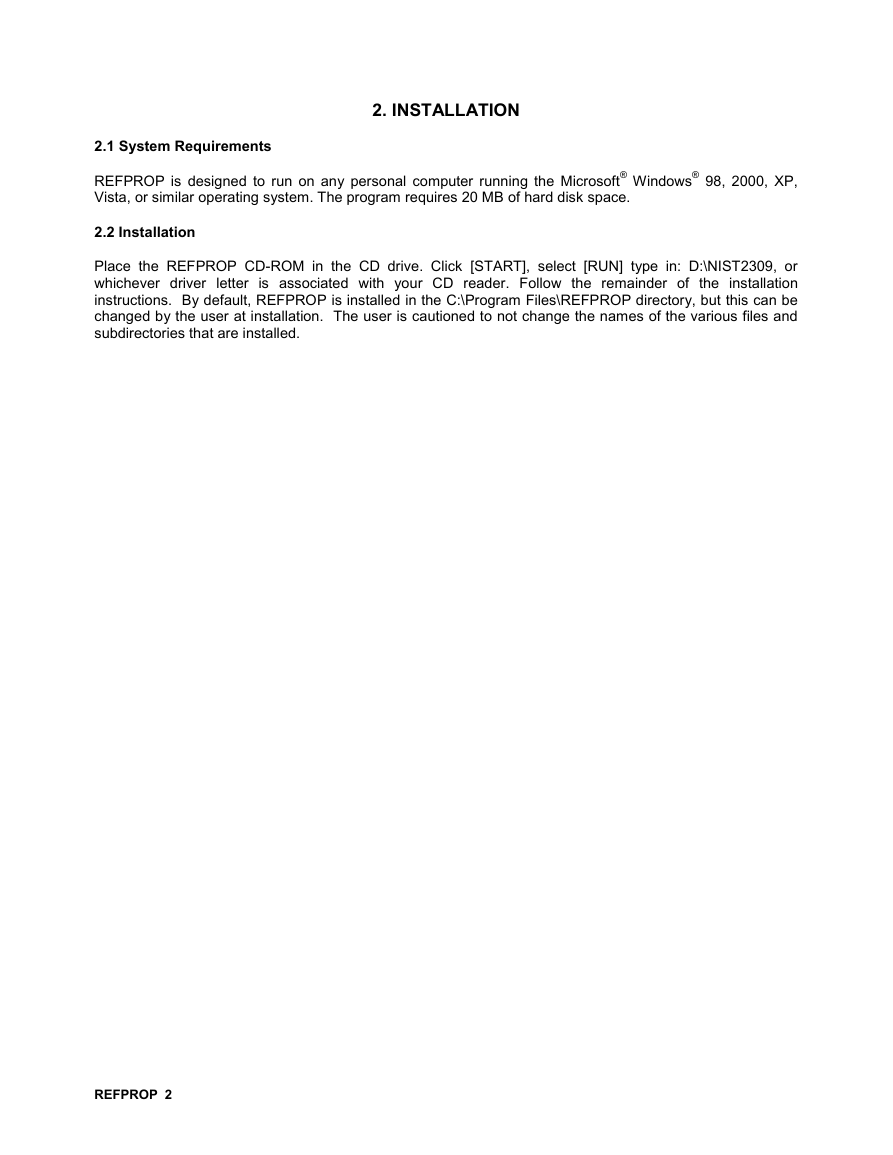








 2023年江西萍乡中考道德与法治真题及答案.doc
2023年江西萍乡中考道德与法治真题及答案.doc 2012年重庆南川中考生物真题及答案.doc
2012年重庆南川中考生物真题及答案.doc 2013年江西师范大学地理学综合及文艺理论基础考研真题.doc
2013年江西师范大学地理学综合及文艺理论基础考研真题.doc 2020年四川甘孜小升初语文真题及答案I卷.doc
2020年四川甘孜小升初语文真题及答案I卷.doc 2020年注册岩土工程师专业基础考试真题及答案.doc
2020年注册岩土工程师专业基础考试真题及答案.doc 2023-2024学年福建省厦门市九年级上学期数学月考试题及答案.doc
2023-2024学年福建省厦门市九年级上学期数学月考试题及答案.doc 2021-2022学年辽宁省沈阳市大东区九年级上学期语文期末试题及答案.doc
2021-2022学年辽宁省沈阳市大东区九年级上学期语文期末试题及答案.doc 2022-2023学年北京东城区初三第一学期物理期末试卷及答案.doc
2022-2023学年北京东城区初三第一学期物理期末试卷及答案.doc 2018上半年江西教师资格初中地理学科知识与教学能力真题及答案.doc
2018上半年江西教师资格初中地理学科知识与教学能力真题及答案.doc 2012年河北国家公务员申论考试真题及答案-省级.doc
2012年河北国家公务员申论考试真题及答案-省级.doc 2020-2021学年江苏省扬州市江都区邵樊片九年级上学期数学第一次质量检测试题及答案.doc
2020-2021学年江苏省扬州市江都区邵樊片九年级上学期数学第一次质量检测试题及答案.doc 2022下半年黑龙江教师资格证中学综合素质真题及答案.doc
2022下半年黑龙江教师资格证中学综合素质真题及答案.doc